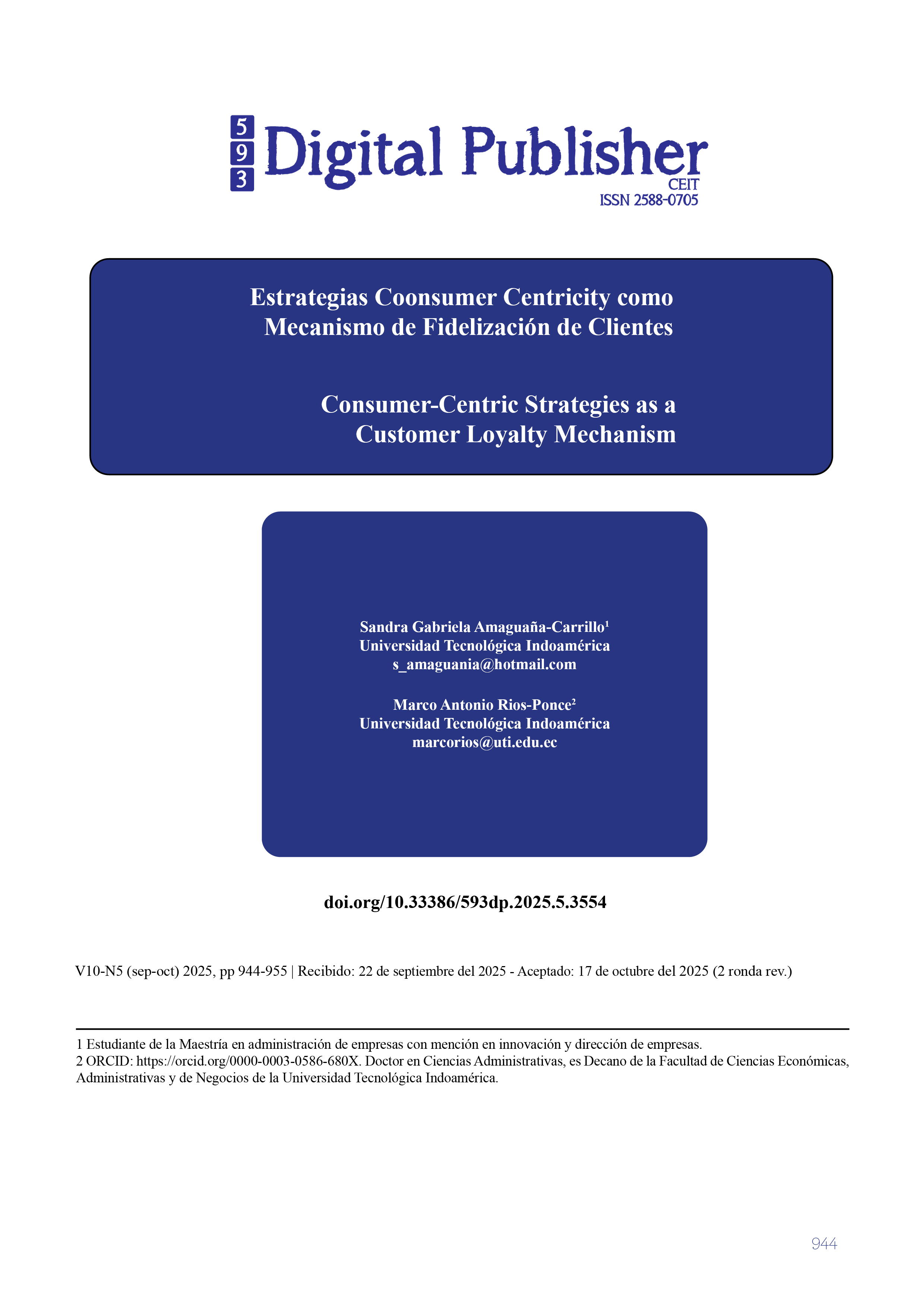Consumer-Centric Strategies as a Customer Loyalty Mechanism
Main Article Content
Abstract
This study proposes customer centric strategies to drive loyalty and retention while embedding continuous improvement. The objective is to translate customer orientation into measurable actions that strengthen competitiveness and contribute to sustainable development. We adopt a qualitative, descriptive–exploratory, non experimental design. We draw evidence from a literature review and case analyses of companies that have implemented customer centric practices, from which we distill transferable patterns. We consolidate the results into five operational pillars: (1) customer oriented governance and culture; (2) customer insight grounded in data and multi source feedback; (3) personalized experience design across the customer journey; (4) enabling technologies—CRM, automation, and artificial intelligence—to scale processes and decisions; and (5) measurement using loyalty, retention, and customer lifetime value indicators. The synthesis provides an executive roadmap to prioritize initiatives, reduce friction at critical touchpoints, increase retention, and sustain improvement over time. The scope focuses on service oriented organizations and excludes field experiments; we frame the recommendations for early adoption and staged implementation.
Downloads
Article Details

This work is licensed under a Creative Commons Attribution-NonCommercial-ShareAlike 4.0 International License.
1. Derechos de autor
Las obras que se publican en 593 Digital Publisher CEIT están sujetas a los siguientes términos:
1.1. 593 Digital Publisher CEIT, conserva los derechos patrimoniales (copyright) de las obras publicadas, favorece y permite la reutilización de las mismas bajo la licencia Licencia Creative Commons 4.0 de Reconocimiento-NoComercial-CompartirIgual 4.0, por lo cual se pueden copiar, usar, difundir, transmitir y exponer públicamente, siempre que:
1.1.a. Se cite la autoría y fuente original de su publicación (revista, editorial, URL).
1.1.b. No se usen para fines comerciales u onerosos.
1.1.c. Se mencione la existencia y especificaciones de esta licencia de uso.
References
AbdelAziz, D. K. (s.f.). Systematic Literature Review: Enhancing Customer Experience through Omnichannel Retailing. Obtenido de journals: https://journals.ekb.eg/article_446135_20620e7a61ada1268c14e0cddd809441.pdf?utm_source=
Accenture. (2018). Personalization Pulse Check. En Accenture, Accenture Interactive.
Baehre, S. (October de 2022). Customer mindset metrics: A systematic evaluation of the net promoter score (NPS) vs. alternative calculation methods. Obtenido de sciencedirect: https://www.sciencedirect.com/science/article/abs/pii/S0148296322003897?utm_source=
Bolton, R. N. (1998). A dynamic model of the duration of the customer’s relationship with a continuous service provider: The role of satisfaction. En R. N. Bolton, Marketing Science (págs. 45–65).
Braun, V. &. (2006). Using thematic analysis in psychology. En V. &. Braun, Qualitative Research in Psychology (págs. 77–101).
Bunge, M. (2004). La ciencia, su método y su filosofía. En M. Bunge, Siglo XXI.
Dawes, J. G. (2023). Qué deben saber los gestores sobre NPS. Obtenido de Journal of Services Marketing (Sage): https://journals.sagepub.com/doi/10.1177/14707853231195003?utm_source=
Denzin, N. K. (1978). The Research Act (2nd ed.). En McGraw-Hill..
Epsilon. (2018). New Epsilon research indicates personalization drives brand engagement. En Epsilon, New Epsilon research indicates personalization drives brand engagement.
Gao, L. (. (September de 2025). The role of customer experience dimensions in expanding customer–firm relationships: A customer expansion journey approach. Obtenido de sciencedirect: https://www.sciencedirect.com/science/article/pii/S0022435925000399?utm_source=
Gao, M. (November de 2021). Quality of channel integration and customer loyalty in omnichannel retailing: The mediating role of customer engagement and relationship program receptiveness. Obtenido de Journal of Retailing and Consumer Services: https://www.sciencedirect.com/science/article/abs/pii/S096969892100254X?utm_source=
GómezUribe, C. A. (2015). The Netflix recommender system: Algorithms, business value, and innovation. En C. A. GómezUribe, ACM Transactions on Management Information Systems (págs. 13:1–13:19).
Hallowell, R. (1996). The relationship of customer satisfaction, customer loyalty, and profitability: An empirical study. En International Journal of Service Industry Management (págs. 27–42).
Homburg, C. J. (2017). Customer experience management: Toward implementing an evolving marketing concept. En C. J. Homburg, Journal of the Academy of Marketing Science (págs. 377–401).
Jayapal, J. (30 de Jun de 2025). Unveiling the Impact of AI-Driven Personalization on Customer Loyalty in Online Shopping: The Moderating Effects of Privacy Concerns. Obtenido de tandfonline: https://www.tandfonline.com/doi/full/10.1080/10496491.2025.2525099?src=&utm_source=
Kannan, P. K. (2017). Digital marketing: A framework, review and research agenda. En P. K. Kannan, International Journal of Research in Marketing (págs. 22–45).
Krippendorff, K. (2013). Content Analysis: An Introduction to Its Methodology. En Content Analysis: An Introduction to Its Methodology. SAGE.
Lemon, K. N. (2016). Understanding customer experience throughout the customer journey. En K. N. Lemon, Journal of Marketing (págs. 69–96.).
Lincoln, Y. S. (1985). Naturalistic Inquiry. SAGE.
McAfee, A. &. (2012). Big data: The management revolution. En A. &. McAfee, Harvard Business Review (págs. 60–68.).
McKinsey & Company Growth, Marketing & Sales. (12 de Noviembre de 2021). Obtenido de The value of getting personalization right—or wrong—is multiplying: https://www.mckinsey.com/capabilities/growth-marketing-and-sales/our-insights/the-value-of-getting-personalization-right-or-wrong-is-multiplying?utm_source=
Miles, M. B. (2014). Qualitative Data Analysis (3rd ed.). SAGE.
Payne, A. &. (2005). A strategic framework for customer relationship management. En A. &. Payne, Journal of Marketing (págs. 167–176).
Quarterly, M. (30 de Jan de 2025). As more consumers seek tailored online interactions, companies can turn to AI and generative AI to better scale their ability to personalize experiences. Obtenido de mckinsey: https://www.mckinsey.com/capabilities/growth-marketing-and-sales/our-insights/unlocking-the-next-frontier-of-personalized-marketing?utm_source=
Reichheld, F. F. (2003). The one number you need to grow. En F. F. Reichheld, Harvard Business Review (págs. 46–55).
Reinartz, W. K. (2004). The CRM process: Its measurement and impact on performance. En W. K. Reinartz, Journal of Marketing (págs. 113–135).
Saldaña, J. (2013). The Coding Manual for Qualitative Researchers. En J. Saldaña. SAGE.
Strauss, A. &. (1998). Basics of Qualitative Research (2nd ed.). SAGE.
Vargo, S. L. (2004). Evolving to a new dominant logic for marketing. En J. o. Marketing.
Verhoef, P. C. (2015). From multichannel retailing to omnichannel retailing. En P. C. Verhoef, Journal of Retailing (págs. 174–181).
Wedel, M. &. (2016). Marketing analytics for data-rich environments. En M. &. Wedel, Journal of Marketing (págs. 97–121).
Wedel, M. &. (2017). Digital marketing: A framework, review and research agenda. En M. &. Wedel, International Journal of Research in Marketing (págs. 22–45).



